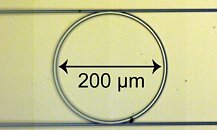Monday, May 25th 2020
Researchers Deliver 44.2 Tbps Speeds on Existing Fiber Optic Infrastructure, Paving the Way for the Future of Communications
A joint team of researchers from Australia's Monash, Swinburne and RMIT universities have developed a new interpretation of the current fiber optic infrastructure - one that managed to deliver a 44.2 Tbps throughput via existing optical lines. The achievement, which delivers speeds in excess of 1 million times greater than the average home users' internet speed (50.2 megabits per second for the US), paves the way for upgrades on the existing fiber optic network that hugely decrease costs compared to the need to implement a wholly new infrastructure.
The feat was achieved using a microcomb - a device which is able to replace a number of the currently in-use lasers for the transmission of information. A microcomb is an optical device that generates very sharp and equidistant frequency lines in a tiny microphotonic chip, and it allows researchers to make use of not only the presence of light - as it's done with the usual lasers found in optical equipment - but the lack of light as well, in what researchers call "dark" pulses of light. While nowadays no user would ever need transmission speeds in the order of the 44.2 Tbps achieved by the researchers, advancement in processing, communication technologies, and supercomputing will eventually make use of these - and even higher - throughputs, which is why it's so important that this technology has been developed on top of existing infrastructure.
Sources:
Engadget, Phys.org
The feat was achieved using a microcomb - a device which is able to replace a number of the currently in-use lasers for the transmission of information. A microcomb is an optical device that generates very sharp and equidistant frequency lines in a tiny microphotonic chip, and it allows researchers to make use of not only the presence of light - as it's done with the usual lasers found in optical equipment - but the lack of light as well, in what researchers call "dark" pulses of light. While nowadays no user would ever need transmission speeds in the order of the 44.2 Tbps achieved by the researchers, advancement in processing, communication technologies, and supercomputing will eventually make use of these - and even higher - throughputs, which is why it's so important that this technology has been developed on top of existing infrastructure.


11 Comments on Researchers Deliver 44.2 Tbps Speeds on Existing Fiber Optic Infrastructure, Paving the Way for the Future of Communications
www.nature.com/articles/s41467-020-16265-x
So with 30Mbps fiber in my house I will have the same lag as my neighbour with 10Gbps connected to the same router.
The only way to have less lag is to eliminate network latency, i.e. playing locally.
About preference for locally installed games, with the ageing and eventually death of my generation (ppl who started gaming in the late 80s up to 2000), young gamers will use their phones over 5G playing simplistic micro-transaction based cloud games. So the fight between local games vs cloud games will solve itself in the next 10-15 years.
Also, look at the new consoles. Both PS5 and XB have mind-blowing SSDs for asset streaming. How could that be possible using a network? If you want high image quality and lag-free experience, at the same time, your only solution is a local high-power gaming machine, be it a PC or console.
Global sales of smartphones are in decline and it's a matter of time before this current fashion fades away.
Who in the right mind would call himself a phone gamer ? This is not serious..